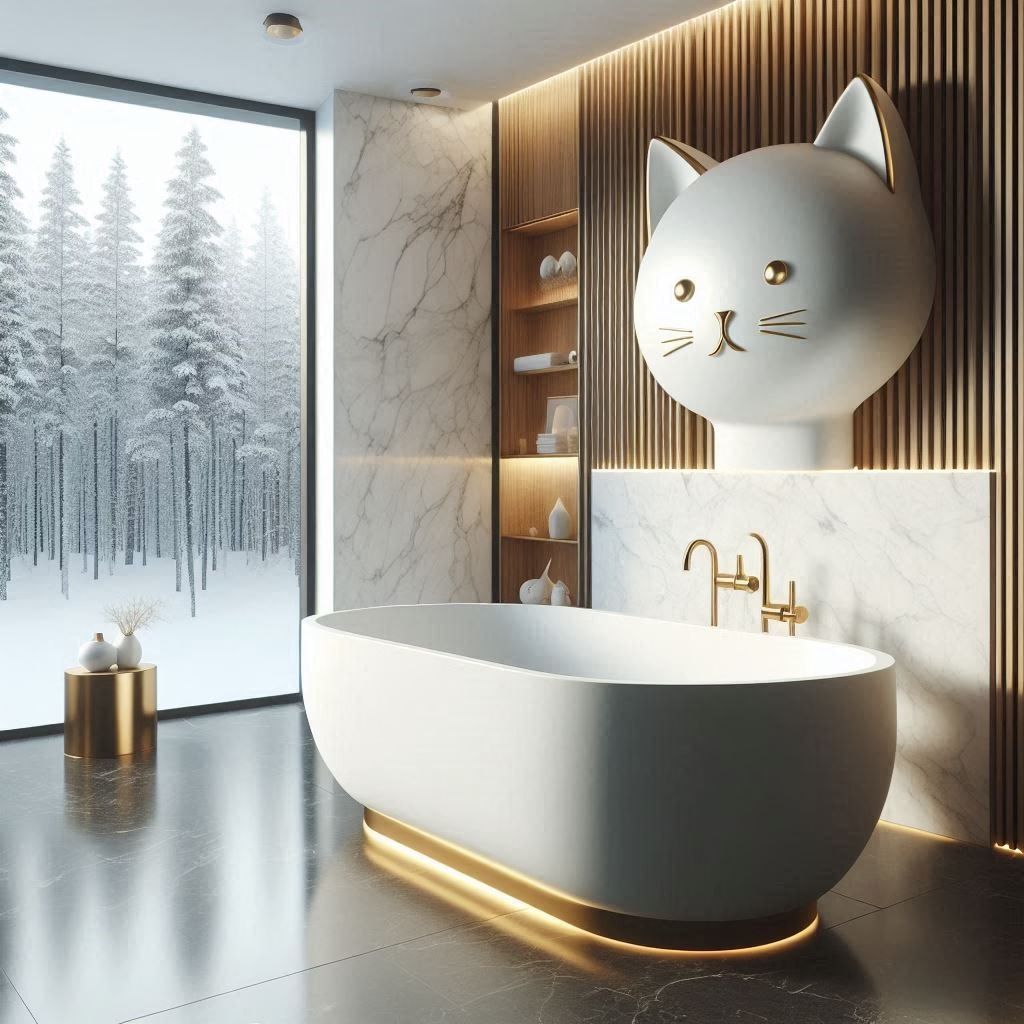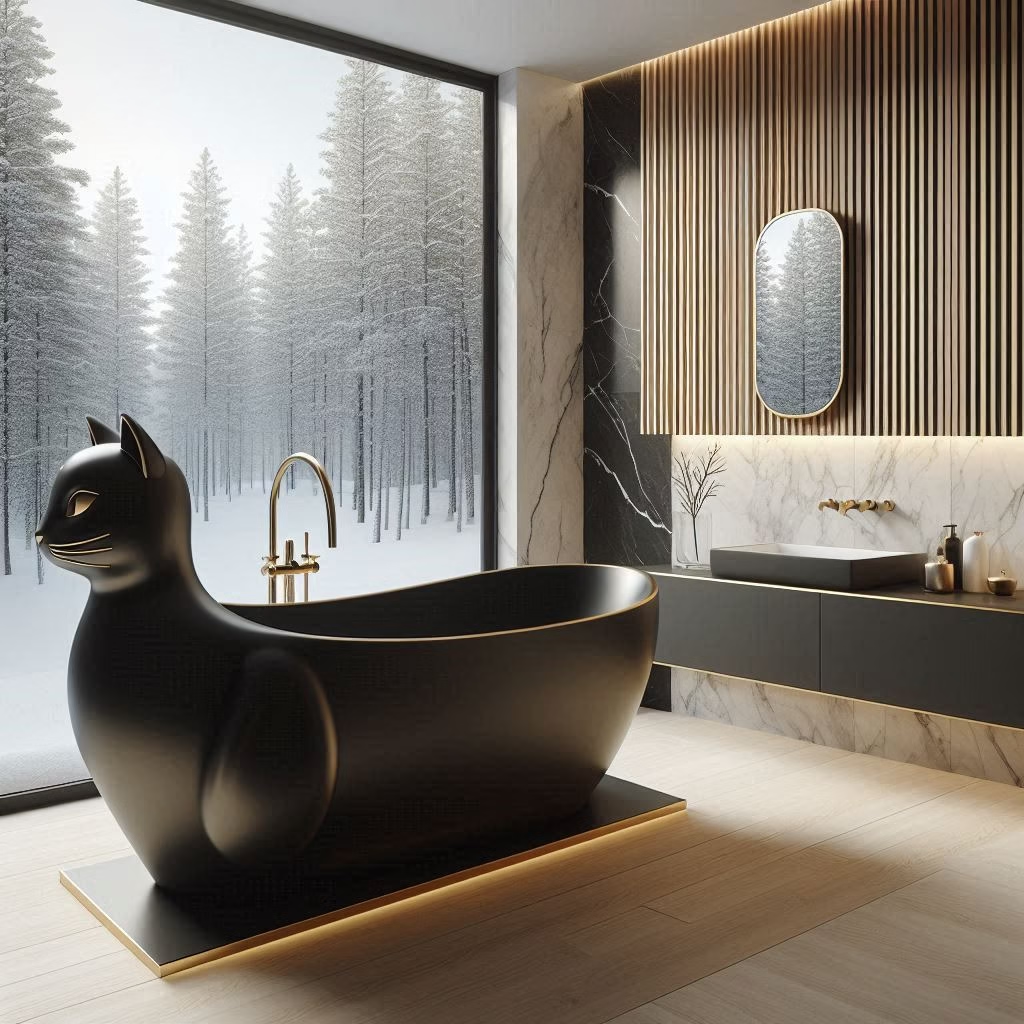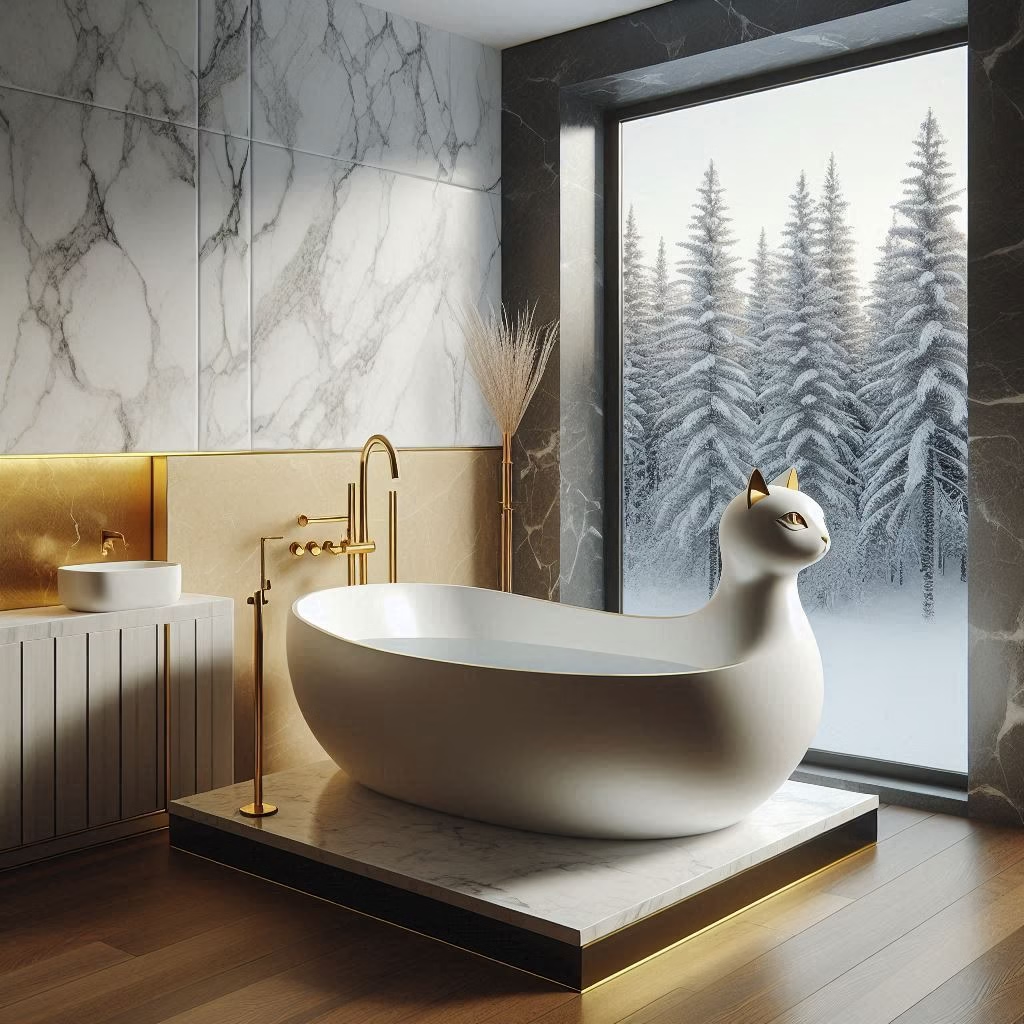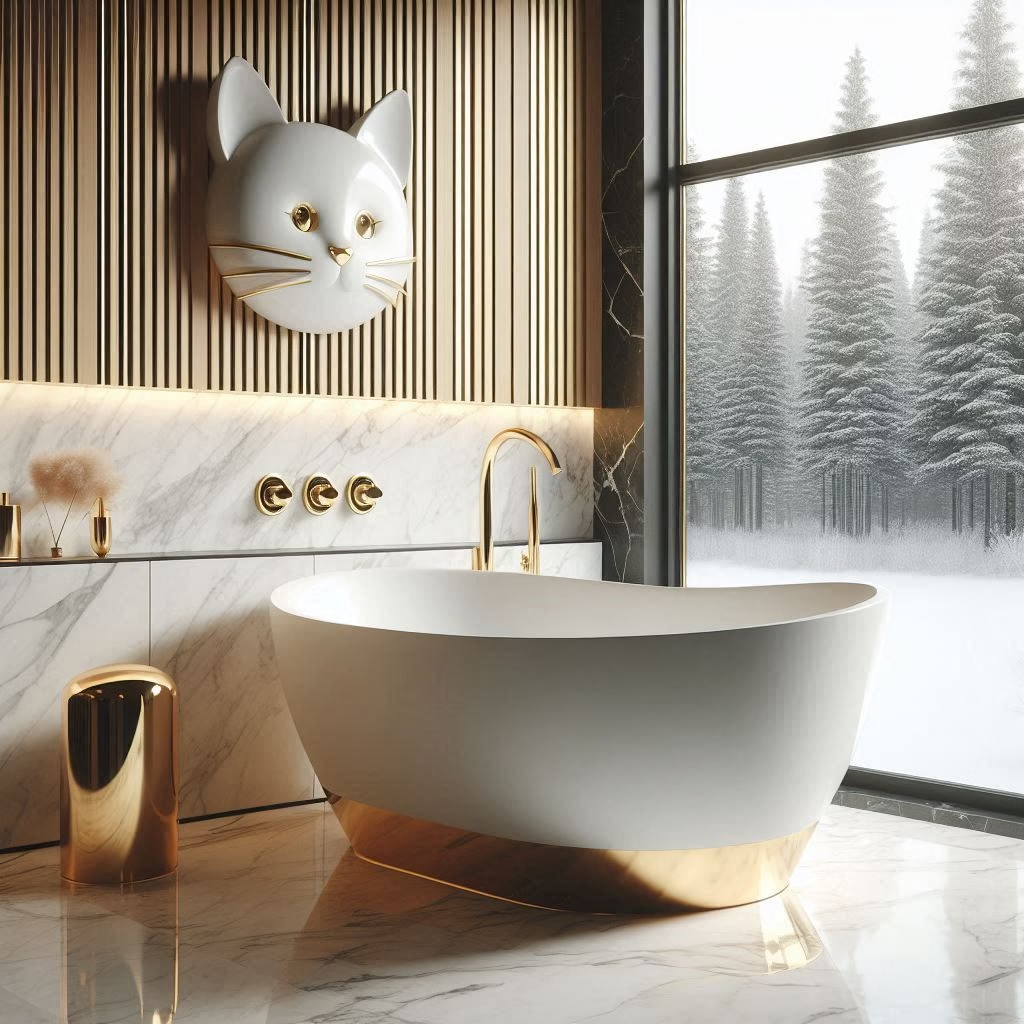Discover the benefits, uses, and features of cat tubs, along with expert tips for selecting the perfect one for your feline friend. Make bath time easy and stress-free!

Introduction
Cats are known for their fastidious grooming habits, but there are moments when even the most diligent kitty needs a little extra help. Whether it’s muddy paws, a skin condition, or a mischievous adventure that ended in a mess, a cat tub can make bath time significantly more manageable for both you and your feline friend.
This guide will walk you through the essentials of cat tubs, exploring their benefits, types, features, and how to choose the perfect one for your cat. Let’s dive in!
What is a Cat Tub?
A cat tub is a specially designed container or bathtub created to accommodate the unique needs of cats during bathing or grooming sessions. Unlike regular bathtubs, cat tubs are smaller, safer, and often include features to make bathing a more pleasant experience for both the cat and the owner.
Benefits of Using a Cat Tub
1. Safety and Comfort
Cat tubs provide a controlled environment, minimizing the risk of your cat slipping or injuring itself. Many tubs include non-slip surfaces and gentle restraints to keep your cat secure during bath time.
2. Ease of Cleaning
With their compact size and ergonomic design, cat tubs are easy to clean and maintain. They often feature smooth edges and drainage systems that allow for quick water removal.
3. Stress Reduction
A cat tub designed for felines helps reduce anxiety during baths. Features like padded walls, calming colors, and adjustable fittings create a soothing space for your cat.
4. Efficiency
Cat tubs require less water than traditional bathtubs, making the bathing process quicker and more eco-friendly. They also prevent water from splashing everywhere, saving you cleanup time.
Types of Cat Tubs
1. Portable Cat Tubs
These lightweight, foldable tubs are ideal for those with limited space. They are easy to store and set up, making them perfect for occasional use.
2. Stationary Cat Tubs
Made for regular use, stationary tubs are durable and often feature integrated accessories like drying racks or grooming attachments.
3. Multi-Functional Cat Tubs
These tubs go beyond bathing, doubling as grooming stations or play areas. They often include adjustable straps, drains, and compartments for supplies.
4. DIY Cat Tubs
Some pet owners opt to create DIY solutions using storage bins or other household items. While cost-effective, these may lack the safety and comfort features of specialized tubs.

Key Features to Look for in a Cat Tub
1. Size and Dimensions
Choose a tub that comfortably accommodates your cat’s size without making them feel confined. Look for tubs with enough depth to hold water but shallow enough for your cat to stand comfortably.
2. Non-Slip Surfaces
A textured base prevents your cat from slipping, ensuring safety throughout the bath.
3. Drainage System
Tubs with built-in drains make water removal effortless, reducing the risk of spills and splashes.
4. Restraints or Harnesses
Gentle restraints can help keep your cat in place, preventing unnecessary movement during bathing.
5. Portable Design
If space is a concern, look for tubs that are lightweight and foldable for easy storage.
How to Choose the Best Cat Tub for Your Feline
Step 1: Assess Your Cat’s Needs
Does your cat enjoy water, or are they skittish during baths? Understanding your cat’s temperament will help you select a tub with features that cater to their comfort.
Step 2: Consider Your Space
If you live in a small apartment, a foldable or portable tub may be the best option. For those with larger spaces, stationary tubs with added features can be a great choice.
Step 3: Look for Quality Materials
Durability is key when investing in a cat tub. Look for tubs made from sturdy, non-toxic materials that can withstand regular use.
Step 4: Read Reviews and Recommendations
Customer reviews can offer insights into the practicality and performance of specific cat tubs. Look for highly rated products that align with your requirements.
Tips for Using a Cat Tub

1. Prepare the Tub in Advance
Fill the tub with lukewarm water before introducing your cat. Keep the water level low to prevent your cat from feeling overwhelmed.
2. Use Cat-Friendly Products
Always use shampoos and conditioners formulated for cats. Human products can irritate their skin and disrupt their natural oils.
3. Introduce the Tub Gradually
If your cat is unfamiliar with the tub, let them explore it before bath time. This helps reduce anxiety and builds positive associations.
4. Keep Bath Time Short
Cats have a low tolerance for water, so aim to complete the bath within 5–10 minutes.
5. Reward Your Cat Afterward
Offer treats or playtime as a reward for a successful bath. This reinforces positive behavior and makes future baths easier.
Popular Cat Tub Brands to Consider
1. Booster Bath for Pets
Known for its sturdy build and elevated design, Booster Bath is perfect for cats who need extra support during baths.
2. Pet Gear Deluxe Tub
Featuring adjustable straps and a removable drain plug, this tub is ideal for grooming and bathing.
3. Trixie Cat Bath Tub
With a non-slip surface and compact design, Trixie tubs are perfect for smaller spaces and occasional use.
4. Furesh Elevated Cat Tub
This elevated tub minimizes the strain on your back and includes a variety of attachments for added convenience.
Maintaining Your Cat Tub

To ensure your cat tub remains in top condition:
- Rinse thoroughly after each use to remove soap residue.
- Allow the tub to air dry completely before storing it.
- Inspect for wear and tear, replacing any damaged parts to ensure safety.
Creative Uses for Cat Tubs Beyond Bathing
While primarily designed for baths, cat tubs can also serve other purposes:
- Grooming Station: Use the tub for brushing and nail trimming.
- Travel Carrier Alternative: Some tubs can double as carriers for short trips.
- Play Area: Turn the tub into a fun, enclosed space filled with toys.
Understanding Your Cat’s Bathing Behavior
Why Cats Might Need a Bath
Cats are naturally clean animals, grooming themselves with their tongues. However, there are occasions when a bath becomes essential:
- Fur Contamination: If your cat gets into something sticky, greasy, or harmful, a bath is necessary to clean their coat.
- Skin Conditions: Certain medical conditions, such as fungal infections or allergies, may require medicated baths.
- Elderly or Obese Cats: Older cats or those with mobility issues may struggle to groom themselves properly, needing occasional baths.
- Hairless Breeds: Breeds like the Sphynx lack a protective fur layer and often need regular baths to remove excess skin oils.
Signs Your Cat is Anxious About Bathing
Recognizing your cat’s body language can help you adjust your approach. Common signs of stress include:
- Flattened ears
- Wide, dilated pupils
- Hissing or growling
- Attempting to escape
If your cat shows extreme fear, consider alternatives like professional grooming services or consulting a veterinarian for advice.
Alternatives to Full Baths

If your cat truly despises water, there are alternatives to full baths that may still meet their hygiene needs:
1. Waterless Shampoo
Specialized cat waterless shampoos can clean their fur without needing a traditional bath. Simply apply and wipe off with a damp cloth.
2. Spot Cleaning
For small messes, use a damp cloth or pet wipes to clean the affected area. This method is quicker and less stressful.
3. Regular Brushing
Frequent grooming with a brush reduces dirt buildup and helps distribute natural oils across your cat’s coat, minimizing the need for baths.
DIY Cat Tub Setup
If you prefer to create your own cat tub at home, here are some tips to ensure it meets your cat’s needs:
1. Choose the Right Container
Opt for a sturdy plastic bin or a baby bathtub with smooth edges. Make sure it’s large enough for your cat to stand and turn around but not so big that it feels overwhelming.
2. Add Non-Slip Padding
Place a rubber mat or towel at the bottom of the tub to prevent slipping.
3. Include a Gentle Restraint
Attach a soft harness or use a towel to gently secure your cat, keeping them calm and stationary during the bath.
4. Test the Setup First
Before introducing your cat, test the tub with water to ensure everything works smoothly, including drainage and stability.
Grooming Accessories to Pair with Your Cat Tub

To enhance the bathing experience, consider these helpful tools:
- Cat-Specific Shampoo: Always choose a pH-balanced shampoo formulated for cats.
- Soft-Bristle Brush: Use this to detangle your cat’s fur before and after the bath.
- Drying Towel or Mat: Invest in an absorbent microfiber towel to quickly dry your cat.
- Pet Hair Dryer: If your cat tolerates it, use a low-heat pet hair dryer for faster drying.
The Future of Cat Tubs: Innovations on the Horizon
The pet care industry is continuously evolving, and cat tubs are no exception. Here are some exciting innovations to look forward to:
1. Self-Cleaning Cat Tubs
Advanced models may include automatic water circulation and filtration systems, making the cleaning process even more convenient.
2. Temperature-Control Features
Future tubs may come equipped with built-in temperature controls to ensure the water stays at a safe and comfortable level.
3. Smart Cat Tubs
Imagine tubs with sensors that monitor your cat’s stress levels, offering soothing vibrations or calming scents during baths.
Transform Bath Time with Patience and Care
With the right tools and techniques, bathing your cat can become less of a chore and more of a bonding experience. A high-quality cat tub, paired with patience and understanding, ensures that your feline friend stays clean, healthy, and comfortable.
Whether you’re a seasoned cat owner or new to feline care, investing in a cat tub is a step toward simplifying bath time for both you and your pet.
Enhancing Your Cat’s Relationship with the Tub

For cats who are especially wary of water, building a positive association with the cat tub can take time. The key lies in gradual desensitization and patience. Here’s how to make the tub a familiar and even enjoyable place for your feline friend:
Creating a Positive Tub Environment
1. Start with Dry Introductions
Before introducing water, place the tub in your cat’s favorite room. Add a soft blanket or a few of their favorite toys to make it an inviting space. Allow your cat to explore the tub on their terms without any pressure.
2. Use Treats as Encouragement
Reward your cat with small treats or gentle praise whenever they approach or sit inside the tub. This helps create a positive connection between the tub and something they enjoy.
3. Introduce Water Gradually
Once your cat feels comfortable in the dry tub, slowly introduce small amounts of water. Start by filling the tub with just enough water to wet their paws. Avoid sudden movements or loud splashes to keep the experience calm.
4. Create a Calming Atmosphere
Play soft music or use a pheromone diffuser in the bathing area to help your cat stay relaxed. Cats are sensitive to their environment, so keeping the area quiet and stress-free is crucial.
Bathing Multiple Cats: Tips for Success
If you’re a proud parent of more than one cat, you may wonder how to manage bath time for multiple pets. Here are some tips to make the process efficient and stress-free:
1. Bathe One Cat at a Time
Bathing cats simultaneously can lead to chaos and increased stress. Focus on one cat at a time to ensure their safety and comfort.
2. Use Separate Tubs
For households with multiple cats, having two or more cat tubs can save time. While one tub is being cleaned and prepped, the next cat can be bathed in a separate tub.
3. Rotate Bath Days
Avoid overwhelming yourself by scheduling baths on different days for each cat. This also gives you the opportunity to provide individual attention.
4. Prioritize Calm Cats First
Start with the calmest cat to set a positive tone for the bathing session. Their relaxed behavior may help reassure more anxious cats.
How to Handle Common Bath Time Challenges
Even with the best preparation, bath time can present challenges. Here’s how to address some common issues:
Challenge 1: Cat Refuses to Enter the Tub
- Solution: Gently lift your cat and place them in the tub while offering treats or toys to distract them. If they continue to resist, take a break and try again later.
Challenge 2: Excessive Scratching or Clawing
- Solution: Trim your cat’s nails before bath time to minimize the risk of injury. Consider wearing gloves for added protection.
Challenge 3: Escaping the Tub
- Solution: Use a soft harness or towel wrap to gently secure your cat in place. Ensure the tub is in a secure area to prevent your cat from bolting away mid-bath.
Challenge 4: Fear of Water
- Solution: Stick to waterless cleaning options for extremely water-averse cats. Gradually introduce water over time to build their confidence.
Caring for Long-Haired Cats: Special Considerations

If you have a long-haired cat, grooming and bathing require extra attention. Their luxurious coats can trap dirt, debris, and even water during baths. Here’s how to manage their grooming needs:
1. Pre-Bath Brushing
Before placing your cat in the tub, thoroughly brush their coat to remove tangles and loose fur. This makes the bathing process smoother and prevents matting.
2. Use a Detangling Shampoo
Choose a cat-safe detangling shampoo that helps loosen knots and keeps their fur soft and manageable.
3. Rinse Thoroughly
Long-haired cats are more prone to shampoo residue, which can irritate their skin. Take extra time to rinse their coat thoroughly.
4. Dry with Care
Use a high-absorbency microfiber towel to remove excess water. If your cat tolerates it, a low-heat pet dryer can speed up the drying process. Avoid letting them air-dry completely, as damp fur can lead to matting or skin issues.
Traveling with a Cat Tub
For cat owners who frequently travel or take their pets on the road, a portable cat tub is an excellent investment. Here’s how to incorporate it into your travel routine:
1. Choose a Foldable Tub
Look for collapsible or foldable cat tubs that are lightweight and easy to pack. These tubs are perfect for road trips, vacations, or visits to the vet.
2. Practice at Home First
Introduce your cat to the portable tub at home before using it on the road. Familiarity with the tub will help them feel more comfortable during travel.
3. Keep It Clean
After each use, rinse and dry the tub thoroughly to prevent bacteria buildup. Store it in a clean, dry bag or container when not in use.
4. Use a Calm Environment
Set up the tub in a quiet, enclosed space, such as a bathroom or pet-friendly hotel room, to minimize distractions and stress during bath time.
Conclusion: Make Bath Time a Breeze with the Perfect Cat Tub
Bathing your cat doesn’t have to be a daunting task. With the right cat tub, you can create a safe, stress-free environment that simplifies the process for both you and your feline companion. By considering your cat’s needs, your space, and the features of available tubs, you can make an informed decision that enhances your pet’s grooming experience.
Invest in a quality cat tub today and transform bath time into a bonding experience your cat will appreciate (or at least tolerate).











